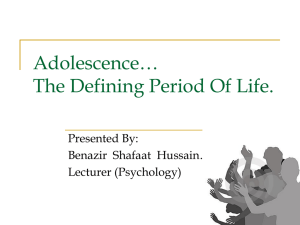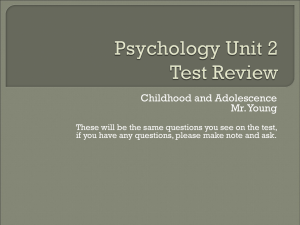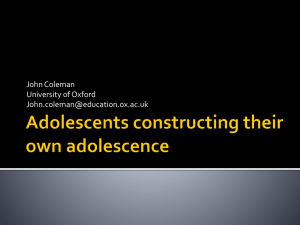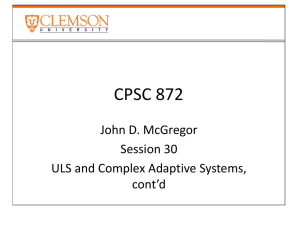Emotional symptoms Personal adjustment - MavDISK
advertisement
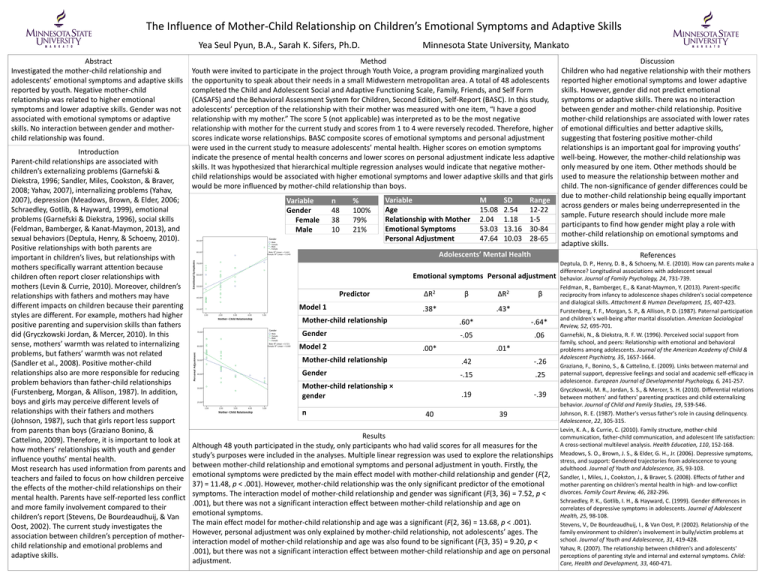
The Influence of Mother-Child Relationship on Children’s Emotional Symptoms and Adaptive Skills Yea Seul Pyun, B.A., Sarah K. Sifers, Ph.D. Abstract Investigated the mother-child relationship and adolescents’ emotional symptoms and adaptive skills reported by youth. Negative mother-child relationship was related to higher emotional symptoms and lower adaptive skills. Gender was not associated with emotional symptoms or adaptive skills. No interaction between gender and motherchild relationship was found. Introduction Parent-child relationships are associated with children’s externalizing problems (Garnefski & Diekstra, 1996; Sandler, Miles, Cookston, & Braver, 2008; Yahav, 2007), internalizing problems (Yahav, 2007), depression (Meadows, Brown, & Elder, 2006; Schraedley, Gotlib, & Hayward, 1999), emotional problems (Garnefski & Diekstra, 1996), social skills (Feldman, Bamberger, & Kanat-Maymon, 2013), and sexual behaviors (Deptula, Henry, & Schoeny, 2010). Positive relationships with both parents are important in children’s lives, but relationships with mothers specifically warrant attention because children often report closer relationships with mothers (Levin & Currie, 2010). Moreover, children’s relationships with fathers and mothers may have different impacts on children because their parenting styles are different. For example, mothers had higher positive parenting and supervision skills than fathers did (Gryczkowski Jordan, & Mercer, 2010). In this sense, mothers’ warmth was related to internalizing problems, but fathers’ warmth was not related (Sandler et al., 2008). Positive mother-child relationships also are more responsible for reducing problem behaviors than father-child relationships (Furstenberg, Morgan, & Allison, 1987). In addition, boys and girls may perceive different levels of relationships with their fathers and mothers (Johnson, 1987), such that girls report less support from parents than boys (Graziano Bonino, & Cattelino, 2009). Therefore, it is important to look at how mothers’ relationships with youth and gender influence youths’ mental health. Most research has used information from parents and teachers and failed to focus on how children perceive the effects of the mother-child relationships on their mental health. Parents have self-reported less conflict and more family involvement compared to their children’s report (Stevens, De Bourdeaudhuij, & Van Oost, 2002). The current study investigates the association between children’s perception of motherchild relationship and emotional problems and adaptive skills. Minnesota State University, Mankato Method Youth were invited to participate in the project through Youth Voice, a program providing marginalized youth the opportunity to speak about their needs in a small Midwestern metropolitan area. A total of 48 adolescents completed the Child and Adolescent Social and Adaptive Functioning Scale, Family, Friends, and Self Form (CASAFS) and the Behavioral Assessment System for Children, Second Edition, Self-Report (BASC). In this study, adolescents’ perception of the relationship with their mother was measured with one item, “I have a good relationship with my mother.” The score 5 (not applicable) was interpreted as to be the most negative relationship with mother for the current study and scores from 1 to 4 were reversely recoded. Therefore, higher scores indicate worse relationships. BASC composite scores of emotional symptoms and personal adjustment were used in the current study to measure adolescents’ mental health. Higher scores on emotion symptoms indicate the presence of mental health concerns and lower scores on personal adjustment indicate less adaptive skills. It was hypothesized that hierarchical multiple regression analyses would indicate that negative motherchild relationships would be associated with higher emotional symptoms and lower adaptive skills and that girls would be more influenced by mother-child relationship than boys. Variable Gender Female Male n 48 38 10 % 100% 79% 21% Variable Age Relationship with Mother Emotional Symptoms Personal Adjustment M 15.08 2.04 53.03 47.64 SD 2.54 1.18 13.16 10.03 Range 12-22 1-5 30-84 28-65 Adolescents’ Mental Health Emotional symptoms Personal adjustment Predictor Model 1 ΔR2 β .38* ΔR2 β .43* Mother-child relationship .60* -.64* Gender -.05 .06 Model 2 .00* .01* Mother-child relationship .42 -.26 Gender -.15 .25 Mother-child relationship × gender .19 -.39 n 40 39 Results Although 48 youth participated in the study, only participants who had valid scores for all measures for the study’s purposes were included in the analyses. Multiple linear regression was used to explore the relationships between mother-child relationship and emotional symptoms and personal adjustment in youth. Firstly, the emotional symptoms were predicted by the main effect model with mother-child relationship and gender (F(2, 37) = 11.48, p < .001). However, mother-child relationship was the only significant predictor of the emotional symptoms. The interaction model of mother-child relationship and gender was significant (F(3, 36) = 7.52, p < .001), but there was not a significant interaction effect between mother-child relationship and age on emotional symptoms. The main effect model for mother-child relationship and age was a significant (F(2, 36) = 13.68, p < .001). However, personal adjustment was only explained by mother-child relationship, not adolescents’ ages. The interaction model of mother-child relationship and age was also found to be significant (F(3, 35) = 9.20, p < .001), but there was not a significant interaction effect between mother-child relationship and age on personal adjustment. Discussion Children who had negative relationship with their mothers reported higher emotional symptoms and lower adaptive skills. However, gender did not predict emotional symptoms or adaptive skills. There was no interaction between gender and mother-child relationship. Positive mother-child relationships are associated with lower rates of emotional difficulties and better adaptive skills, suggesting that fostering positive mother-child relationships is an important goal for improving youths’ well-being. However, the mother-child relationship was only measured by one item. Other methods should be used to measure the relationship between mother and child. The non-significance of gender differences could be due to mother-child relationship being equally important across genders or males being underrepresented in the sample. Future research should include more male participants to find how gender might play a role with mother-child relationship on emotional symptoms and adaptive skills. References Deptula, D. P., Henry, D. B., & Schoeny, M. E. (2010). How can parents make a difference? Longitudinal associations with adolescent sexual behavior. Journal of Family Psychology, 24, 731-739. Feldman, R., Bamberger, E., & Kanat-Maymon, Y. (2013). Parent-specific reciprocity from infancy to adolescence shapes children's social competence and dialogical skills. Attachment & Human Development, 15, 407-423. Furstenberg, F. F., Morgan, S. P., & Allison, P. D. (1987). Paternal participation and children's well-being after marital dissolution. American Sociological Review, 52, 695-701. Garnefski, N., & Diekstra, R. F. W. (1996). Perceived social support from family, school, and peers: Relationship with emotional and behavioral problems among adolescents. Journal of the American Academy of Child & Adolescent Psychiatry, 35, 1657-1664. Graziano, F., Bonino, S., & Cattelino, E. (2009). Links between maternal and paternal support, depressive feelings and social and academic self-efficacy in adolescence. European Journal of Developmental Psychology, 6, 241-257. Gryczkowski, M. R., Jordan, S. S., & Mercer, S. H. (2010). Differential relations between mothers' and fathers' parenting practices and child externalizing behavior. Journal of Child and Family Studies, 19, 539-546. Johnson, R. E. (1987). Mother's versus father's role in causing delinquency. Adolescence, 22, 305-315. Levin, K. A., & Currie, C. (2010). Family structure, mother-child communication, father-child communication, and adolescent life satisfaction: A cross-sectional multilevel analysis. Health Education, 110, 152-168. Meadows, S. O., Brown, J. S., & Elder, G. H., Jr. (2006). Depressive symptoms, stress, and support: Gendered trajectories from adolescence to young adulthood. Journal of Youth and Adolescence, 35, 93-103. Sandler, I., Miles, J., Cookston, J., & Braver, S. (2008). Effects of father and mother parenting on children's mental health in high- and low-conflict divorces. Family Court Review, 46, 282-296. Schraedley, P. K., Gotlib, I. H., & Hayward, C. (1999). Gender differences in correlates of depressive symptoms in adolescents. Journal of Adolescent Health, 25, 98-108. Stevens, V., De Bourdeaudhuij, I., & Van Oost, P. (2002). Relationship of the family environment to children's involvement in bully/victim problems at school. Journal of Youth and Adolescence, 31, 419-428. Yahav, R. (2007). The relationship between children's and adolescents' perceptions of parenting style and internal and external symptoms. Child: Care, Health and Development, 33, 460-471.


